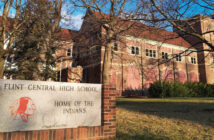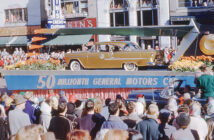From the mid-1940s to the beginning of the 1960s, Flint was operating at peak efficiency and success. General Motors was nearly unrivaled in car production, Flint schools were the envy of the state in both education and sports programs, impactful social groups and organizations were being started, infrastructure updated and major businesses were built. Parades and celebrations dotted the time period between multiple visits from presidents and presidential hopefuls on the campaign trail. It was also during this time that Flint proved to the nation how resourceful and close-knit a community could be after the Beecher Tornado ripped through in 1953 and disrupted hundreds of lives. The mayors of this time period had to simply sit back and let progress happen and were mostly concerned with necessity improvements (water) and expansion.
This series has tracked each of Flint’s mayors throughout history, providing a short account of their professions, lives and decisions in office (if known). Some mayors were men/women of great deeds or of great controversy; some simply acted as placeholders in time. Each of them, however, chaired a city important to its country and citizens on a path through triumph and heartbreak, and toward revitalization.
For Part 1 in this series, see the January 2022 issue of MCM.
Edwin C. McLogan – 1944-46
Born in Chicago, IL in 1889, McLogan moved to Calumet, MI at the age of nine. His father, John C. McLogan, owned and operated music stores under the name of McLogan & Pierce with locations in Calumet, Hancock and Iron Mountain. Edwin McLogan learned the ways of business working for his father until the breakout of World War I when he enlisted in the United States Army. He was promoted to major of the 10th U.S. Infantry and commanded his regiment through many important campaigns in France. After the armistice, McLogan stayed for a time in France, returning home in 1919. Months after his return, he moved to Flint to start a business with his partner Edward D. Austin. Within a year, they opened The China Closet at 517 S. Saginaw St., (near the current location of Blackstone’s Smokehouse) selling fine china and dinnerware. In 1938, he became a member of the Genesee County Board of Supervisors and as mayor, he lobbied heavily to bring more natural gas to the city to help heat the new developments and homes. McLogan was a member of the rotary club, Order of the Elks, a Noble of the Mystic Shrine, and Freemasons. During his tenure, Flint was operating as a big-time producer of tanks and weapons of war with nearly every factory converted and dedicated to the effort. On August 14, 1945, a spontaneous victory celebration erupted in the city followed two days later by a victory parade. Also during this time, the Big Brother Association was started by Joseph T. Ryder and the Mott Foundation moved into the Union Industrial Bank building where it now resides. Edwin C. McLogan died in 1949.
Edward J. Viall – 1946-48
Born in 1890 in Plattsburgh, NY Viall grew up and became an engineer with the Lozier Motor Company which specialized in luxury cars. During his short time with the firm, Lozier produced the nation’s most expensive vehicles. The company would close in 1918, sending Viall to Flint as an engineer at General Motors. Being civic minded, he served on the city commission and then as mayor, guiding the city through its worst flood in 1947. In 1939, Viall released a book of poetry entitled An Evening In … and other Poems, to be followed by three more: Passing Through (1940), Yankee Spirit (1942) and Looking Forward (1944). His poem “To the Blue Star Mothers” was read in Congress to honor the Blue Star Organization. The final verse reads:
“So, let’s pay an honored tribute,
To the mothers of today,
Who have within their window,
A blue star upon display.
Let their names go down in history,
As an army strong and great,
For they also serve their country,
Who just stand aside and wait.”
Edward J. Viall died in 1950.
George G. Wills – 1948-50
George Gill Wills was born in 1903 in Houghton, MI. After graduating from Michigan State Normal College, he settled in Flint, took on multiple civic opportunities and served on the city commission. As mayor, Wills was concerned with increasing housing opportunities in the city and lobbied Congress on a few occasions to pass a National Housing Bill that would assist the city in the construction of low-rent public housing. After taking office, he greeted Harry S. Truman and conducted a parade for the president during his election campaign. In the winter of 1949, Wills declared a state of emergency during a city-wide coal shortage in an attempt to bind dealers and consumers to a rationing plan in order to keep city residents from freezing. It was reported that some 200 families were in dire need of heat. In 1961, Wills made one more attempt at public service and was a primary election candidate for Michigan State Constitutional Convention delegate. Wills died in 1983 and was buried in Gracelawn Cemetery.
Paul C. Lovegrove – 1950-52
Paul C. Lovegrove was born in Pennsylvania in 1910. He was elected mayor after a bitter fight for control of the city commission pitting a joint effort of the UAW-CIO and the Flint Fair Employment Practices Commission (FFEPC) against General Motors. After the war, the UAW-CIO held a slim majority in the city commission and used its slight majority to protect workers’ rights. Heading into 1950, the FFEPC was fighting against discriminatory employment practices centered on GM factories. They aligned with the UAW-CIO to hopefully gain advantage in the city commission in order to pass fair employment legislation. GM united with Flint Journal Editor Michael Gorman to select and push pro-business candidates. The UAW-CIO subsequently lost its advantage in the commission; Lovegrove, backed by GM, was chosen mayor. When the vote to pass fair employment legislation came up in October of 1951, it was defeated 6-3. Lovegrove defended his negative vote by asserting that the legislation would drain city coffers and that it was impossible to “legislate away” racial prejudice. During the same year that Lovegrove was passing his vote, McLaren Hospital opened in Flint.
Donald W. Riegle, Sr. – 1952-54
Born in 1917, Donald W. Riegle, Sr. was raised, from the age of 11, in Davison Township having been adopted after his mother’s marriage to John L. Riegle. (His biological father, Roy Tenny Smith was an AC Spark Plug worker from the thumb area of Michigan.) Riegle’s father opened and established the Riegle Press of which Donald dedicated his life to as sales representative and officer. Backed by General Motors, Reigle, Sr. served as a pro-business city commissioner from 1950-52 and was subsequently chosen mayor. Politics in Flint were hot-blooded and, being thought of as a GM pawn, Riegle was serving as commissioner when an unknown assailant took out the front window of Riegle’s house with a shotgun. Riegle’s term as mayor was loaded with excitement and tragedy. He welcomed Harry S. Truman on his second visit and in 1953, the first Corvette rolled off the assembly line. In perhaps Flint’s biggest celebration, Riegle and the city saluted GM’s 50-millionth car with a grandiose parade. Tragedy struck on June 8, when the Beecher Tornado touched down killing 116 people, injuring more than 900 and destroying more than 300 homes. The response from the city government and its people was nothing short of heroic, however. The effort earned the city the “All-American City Award.” Donald W. Riegle’s son, Donald Riegle, Jr., would go on to become a United States Representative from 1966-1976 and senator from 1976-95. Donald W. Riegle, Sr. died in 1992.
George M. Algoe – 1954-58
George M. Algoe was born in Flint in 1898, the son of tinner J. Frank Algoe. He worked as secretary, treasurer and partner of the Algoe-Gundry Company Funeral Directors – the county’s oldest such establishment (located at 703 Beach St., now demolished). As mayor, Algoe was industrious. His tenure began with the launch of the Flint Cultural Center Project, which established the Flint Institute of Arts, planetarium, Whiting Auditorium and more. In 1955, Flint Junior College (Mott Community College) went into operation and the city’s centennial celebration, dubbed the Golden Carnival, attracted more than 200,000 spectators including Vice President Richard Nixon who dedicated Flint’s new Municipal Center. At the time, Algoe stated, “the dedication of this magnificent Municipal Center is a time of triumph” and, the “structures will remain as a testament to those that follow us that we build well the foundations for the future.” He then bragged that Flint was the “envy of all other industrial cities.” The next year, the University of Michigan-Flint opened its campus. As soon as he took office, Algoe began working on a new municipal center and found engineers Robert Moses, William S. Chapin and Gilmore D. Clarke to choose its location and initial design. A citizen committee selected the firm of H. E. Brewster and Associates to finalize. Algoe was able to get the new city hall finished and opened in April of 1958. After his death in 1968, it was proposed to name the I-475 expressway in his honor.
Robert J. Egan – 1958-60
When Robert J. Egan took the reins as mayor in 1958, the City of Flint and General Motors were gearing up to celebrate GM’s 50th anniversary. The city was flying high and everyone was happily praising the future. Egan was perhaps the first to see cracks forming in the foundation. At the beginning of his term, Flint was experiencing nearly 14% unemployment (today’s rate is roughly 6%) and people were beginning to leave the city for the suburbs, taking their tax money and expertise with them. When Flint began to extend water out to the suburbs before he took the helm, Egan warned that businesses would follow and that water supply would become a major problem. Unfortunately, he was correct. In an attempt to slow future problems in 1959, Egan, as a representative of the American Municipal Association, lobbied congress to pass H. R. 5944, known as the Community Facilities Act, to help the city install new water infrastructure. With the money the act provided, Egan stated that Flint could start the process of building an aqueduct from Lake Huron to provide a larger source of water. Arguments were made against the money being given to Flint because, it was claimed, Flint was not a poor city. This was true. Flint had a population of over 200,000 persons and taxes were being collected at a rate of 97.8%. Egan was looking to the future; Congress was looking at the ledger. Egan also worried about being tied to one industry only, realizing that at any moment, GM could leave or automobile sales would end. In answer, he formed a committee to work for a diversified industry base in Flint. History will show his efforts were too late. Egan also dealt with the city’s first major civil rights protest when a young, black woman was arrested for loitering despite claims she was simply walking home. It was the first sign of major tension and social change in the city. In 1958, the Flint Public Library opened its doors and the first Buick Open took place at Warwick Hills Golf & Country Club. In the summer of 1959, Egan opened Southwestern High School to its first students.
Charles A. Mobley – 1960-62
When John F. Kennedy spoke in 1960 at Atwood Stadium about the dangers of automation for a working city like Flint, Mayor Charles A. Mobley listened. He, like Egan before him, was concerned with Flint’s future, especially as automation was concerned. Employment continued to fall in Flint and the citizen exodus to the suburbs was continuing. Mobley hitched up his belt and made his way to Congress where he lobbied for H. R. 4569, known as the Area Redevelopment Act, in an effort to acquire federal funds to create a program to retrain employees supplanted by automation. His efforts went the way of Egan’s for much the same reasons. Meanwhile, the cracks in Flint’s automotive foundation were getting wider and neither Mobley nor Egan could even begin to patch them. While in office, Mobley created a Department of Industrial Development in another effort for diversification. This effort continues without much success into today. After his tenure, Mobley ran for state representative twice in 1962 and 1964. He served as a long-time member of the Parks Board and Mobley Park, located across from Powers Catholic High School, is named after him. Also, during his mayoral term, Flint hired Joe Davis, the city’s first black fireman.








